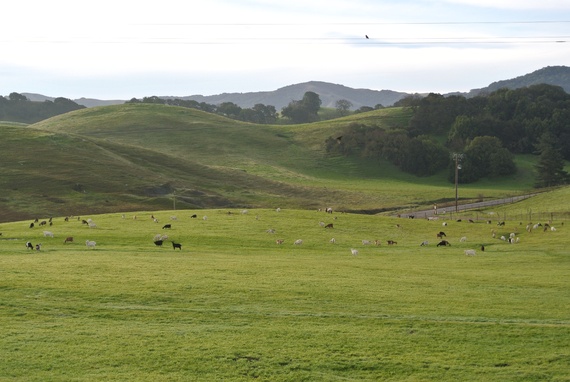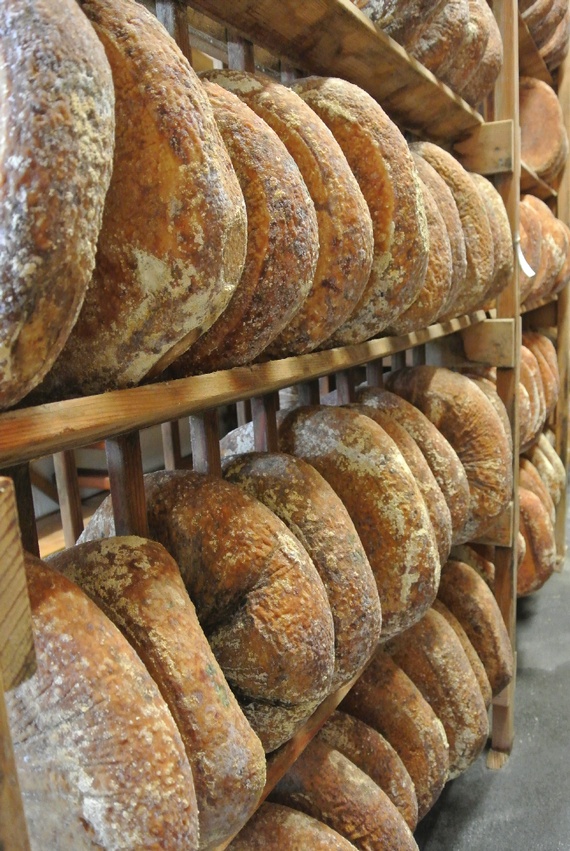In many cities these days, cheeses described as “small-batch” and “artisanal” dot the shelves of farmer’s markets the supermarkets alike. These descriptors probably conjure images of an aproned farm maid milking her cows by hand and then spending the afternoon turning her sloshing buckets into cheddar or mozzarella. The reality is that while artisanal cheesemaking certainly depends on the care and skill of a knowledgeable maker, the picture of an idyllic, technology-free farm isn’t quite right. Modern cheesemaking, even the artisanal kind, uses technology and a less quaint, but more safety-oriented approach to produce the high-quality wedges and rounds that will grace cheese plates around the country over the coming holiday season.
Take Donna Pacheco, the owner of Achadinha Cheese Company in Marin County, California, for example. Her farm—which has been in her husband’s family for more than 50 years and is now run by the two of them and their four children—sits atop one the area’s many hills, with verdant green pastures dotted with grazing animals surrounding the classic farmhouse where the family lives and the collection of barns at the end of a dirt driveway. Pacheco is also the quintessential farmer, wearing muck boots as she moves through her morning chores, a shaggy dog following close behind. Her cheesemaking and farming are closely connected, she says, with the pastureland, milking room, and aging room all within sight of each other. Yet while Pacheco is involved in every aspect of cheesemaking, she has mechanical help too.

A visit to the small cheesemaking house, built expressly for that task, feels more like entering the sterile, modern confines of a hospital room. While most small-batch food production needs to follow specific food safety laws, cheesemaking is particularly regulated because of the dairy industry’s high potential for spreading illness. Pasteurization standards were put into effect in 1933, when at least a quarter of food- and water-born ailments could be traced to contaminated milk, and modern facilities are built with these regulations in mind.
Cheesemaking starts with milk, of course, and at the Pacheco farm the cows are milked by metal milking machines. Pacheco explained that this automated method is significantly faster, cleaner, and more thorough than milking by hand. The Pachecos know when the animals are done being milked because the clear tubes that lead from the machine directly to a refrigerated tank are empty. Thus the milk never touches human hands until well into the cheesemaking process.

(Photo courtesy of Suzanne Cope)
This process starts when chilled raw milk flows into the pasteurizer, a large stainless steel vat in a sterile room. There, it is slowly heated to 145 degrees—the lowest temperature at which it must be held for 30 minutes, by law, to ensure that pathogens are eliminated. After pasteurization, the milk is cooled slightly before being transferred to the cheesemaking table. Pacheco, now fully dressed in hairnet, smock, and shoes only worn in the building, is overseeing this process, which is mechanized and facilitated by a highly calibrated system. It is only after the milk is transferred to the cheesemaking table, that Donna starts to work her cheese by hand.
Here is where Donna adds the rennet—the enzymes which curdles the milk to begin the process of making cheese—to the milk. Next she agitates the large vat by hand with a large paddle—some small-batch makers also have a mechanized agitator—and the pH of the young cheese is frequently checked using a commercial meter. But one thing a machine cannot do is tell when the cheese is done. That is up to Pacheco, and her years of experience. “I’ve done it so many times that I just know,” she says, of these last steps, during which she assesses the cheese by look and feel, rather than by timer or formula. It is here where the hand of the cheesemaker is most felt in the final product, adding value that cannot be replicated by a machine.
Donna’s cheeses have won awards and are well received by consumers. But her process is not all that different from the vast number of small-batch cheesemakers around the country. The American Cheese Society defines “artisanal” cheese as “impl[ying] that a cheese is produced primarily by hand, in small batches, with particular attention paid to the tradition of the cheesemaker’s art, and thus using as little mechanization as possible in the production of the cheese.” Yet in almost all artisanal cheese companies, large and small, the livestock is milked mechanically, the milk is brought through a pipeline to the cheesemaking room to combat contamination, and is pasteurized using an automated system. Even after the cheese has been moved to the table, its characteristics are monitored by digital tools as much as by human instinct.
This isn’t a bad thing. It cuts down on disease and keeps people from getting sick. And it is the interplay of technology and skill that helps to hone that knowledge as the cheesemaker adapts to the seasonality of the milk or climate conditions.
Of course, the packaging of artisanal cheese is purposefully pastoral and images of the farmers hugging their livestock with green rolling hills in the background are de rigeur. And this seems to be the narrative that the consumers want: to see livestock that is well cared for and a product made primarily by hand by someone who has long practiced their craft. In reality, Pacheco and other small-batch cheesemakers wear hairnets and not aprons, and their work space resembles an operating room more than a cluttered farmhouse kitchen. Yet this reliance on technology for the steps that need safety and precision combined with skill and intuition to hone flavor and texture, is the new standard for artisanal cheeses today. Traditional knowledge is still necessary to make modern artisanal cheeses, but the best cheesemakers have learned to work with technology to make a high quality, safe, and, of course, delicious product for the modern small-batch food consumer.
This article was originally published at http://www.theatlantic.com/technology/archive/2014/11/the-high-tech-of-small-batch-cheese/382958/


















